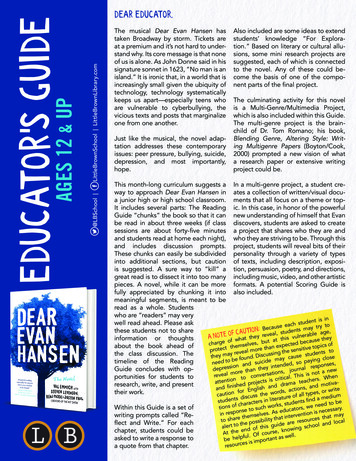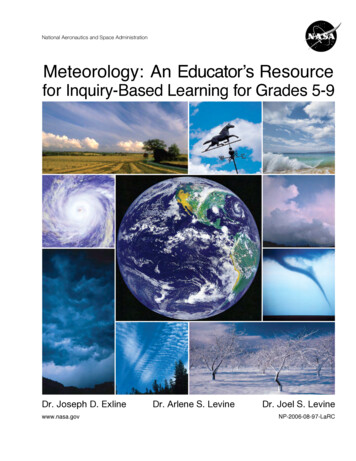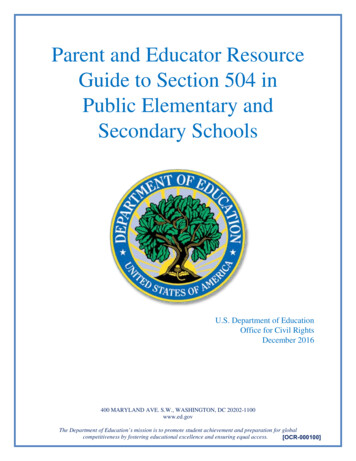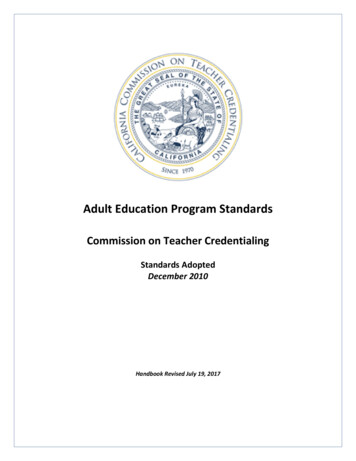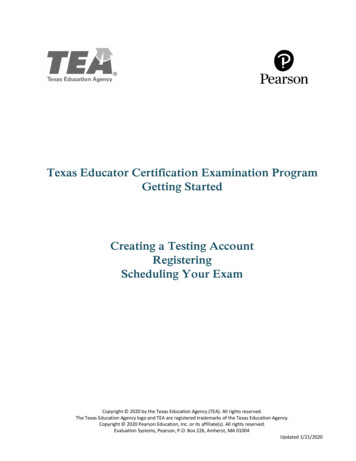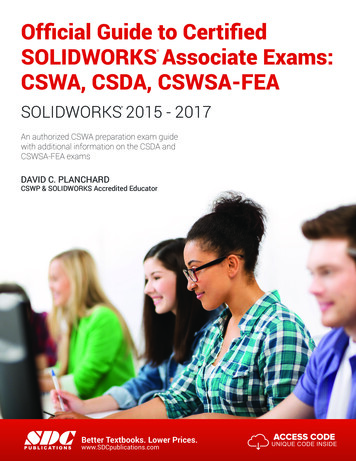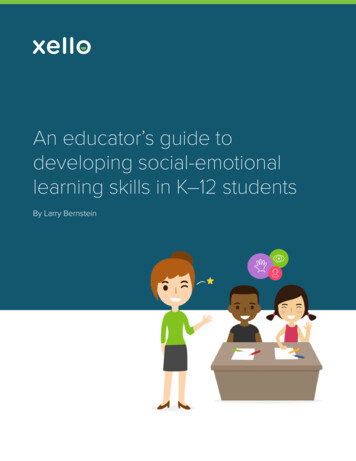
Transcription
An educator’s guide todeveloping social-emotionallearning skills in K–12 studentsBy Larry Bernstein
Introduction . . . . . . . . . . . . . . . . . . . . . . . . . . . . . . . . . . . . 3Making the case for social-emotional learning (SEL) . . . . . . . . . . . . . . 4Putting it into action . . . . . . . . . . . . . . . . . . . . . . . . . . . . . . . . 8Unlocking the magic . . . . . . . . . . . . . . . . . . . . . . . . . . . . . . .11Create a safe space for classroom discussion . . . . . . . . . . . . . . . . . . .12Encourage collaboration . . . . . . . . . . . . . . . . . . . . . . . . . . . . .13Lean on an SEL-rich online program . . . . . . . . . . . . . . . . . . . . . . . . 14How Xello helps k-12 students expand their SEL skills . . . . . . . . . . . .15Conclusion, the value of SEL . . . . . . . . . . . . . . . . . . . . . . . . . . . 17
INTRODUCTION:Developing well-rounded studentsto create successful futuresLet’s start from the beginning: What is the purpose of an education?While a very broad question, the answer boils down to this: The purpose of aneducation is to acculturate young people and prepare them with the skills they needto be productive members of society. Productivity generally translates into beingprepared to assume a job. And we know that—with the foundation we’re building inthe classroom today—our hope is to see students succeed in the workplace.Therefore, districts should constantly strive to look at their curriculum through twolenses: One that builds the technical skills they need to perform in their future jobs,and one that develops the soft skills they need to rise to the top. With this in mind,schools need to infuse their curriculum to introduce social-emotional learning.3
Making the case forsocial-emotional learning(SEL)4
Making the case for social-emotional learning (SEL)SEL became part of the lexicon in the mid 1990s. Schools have been adapting it ever since,though it has gained momentum over the last few years.Though SEL is relatively new, Edutopia says SEL can be traced back to ancient Greece andPlato. In his book The Republic, the philosopher “proposed a holistic curriculum that requires abalance of training in physical education, the arts, math, science, character, and moral judgment.”Plato felt, with a “sound system of education and upbringing, you produce citizens of goodcharacter.”Let’s take a step back to clarify what SEL is.Collaborative for Academic, Social, and Emotional Learning (CASEL), the nation’s leadingorganization advancing the development of academic, social, and emotional competence for allstudents, offers a definition of SEL: “The process through which children and adults understandand manage emotions, set and achieve positive goals, feel and show empathy for others,establish and maintain positive relationships, and make responsible decisions.”CASEL divides SEL into five core competencies: self-awareness, self-management, socialawareness, relationship skills, and responsible decision-making.This might sound all nice and good, positive and pleasant, but does it really need to be taught inschools? After all, it was not taught in the past, and most students seemed to do just fine withoutit. On top of that, students today need to be groomed so they can contribute and compete inthe new digital economy. Shouldn’t precious learning time be spent training students onpractical knowledge they’ll need to advance in the workplace?5
Making the case for social-emotional learning (SEL)Much research has been done to determine what, if any, value is gainedby inculcating SEL into an educational setting. The results clearlyindicate that an education that includes SEL is beneficial for students. Consider this study, which found that students who are “SEL participants demonstratedsignificantly improved social and emotional skills, attitudes, behavior ” The studyfurther explains how a lack of social emotional competency has a negative impact: “ many students lack social-emotional competencies and become less connected toschool as they progress from elementary to middle to high school, and this lack ofconnection negatively affects their academic performance, behavior, and health.” The study cited above also notes an academic benefit to SEL. Participating studentssaw an 11% gain in academic achievement compared with the control group. This study corroborated the findings noted above. It found that students in schools withan SEL program improved academically by 27% versus students in schools without anSEL program. There was a 24% improvement when testing for emotional well-beingand social behavior. Furthermore, positive benefits are “evident immediately followingthe end of intervention and persist during various follow-up periods.” The conclusionis that, based on the data, SEL programs are both feasible and effective in a variety ofeducational contexts in many countries around the world. And more proof! This study found that “on average, for every dollar invested equallyacross the five SEL interventions, there is a return of eleven dollars.”6
Making the case for social-emotional learning (SEL)Clearly, SEL helps students in school. However, as noted in the introduction, the purpose ofeducation is to prepare students to be productive adults. To make SEL truly valuable in the worksetting, it should positively impact students in the long-term.And it does. This study published in the American Journal of Public Health “found statisticallysignificant associations between measured social-emotional skills in kindergarten and keyyoung adult outcomes across multiple domains of education, employment, criminal activity,substance use, and mental health.”Finally, this study, subtitled “A Consensus Plan for Reducing Povertyand Restoring the American Dream,” cites SEL. It says SEL “may bethe key to making low-income schools work.” Thus, it can helpelevate students who come from poor backgrounds.There’s enough evidence out there that backs SEL as a part part ofevery curriculum. It helps fulfill the aims of education and enablesstudents to grow into productive competent adults.7
Putting it into action: realSEL skills that studentscan learn in school8
Putting it into action: real SEL skills that students canlearn in schoolWhile the benefits of implementing SEL into K–12 education has been proven, the questionshifts to how SEL can be turned into action.Which skills should be emphasized that will enable students to move forward?Since one of the goals of all education, including SEL, is the capability to cope in the real world,it’s helpful to consider what skills employers want. Note that LinkedIn found 57% of seniorleaders feel “soft skills are more important than hard skills.”Think about the process of getting, maintaining, and succeeding at a job. Being adept at SEL willbenefit one throughout this cycle.Before landing a job, there’s the interview which starts with a handshake. Although some mayview a handshake as intuitive, The Balance offers 10 tips regarding how to give a properhandshake. These include beginning with an introduction to not using a forceful grip (or offeringa fish hand) to ending the handshake. A handshake involves self-awareness and socialawareness, two core SEL competencies.Every job has its stressful moments. The ability to calm oneself and focus on the task at hand isa valuable skill and is the heart of self-management. More schools are teaching studentsmeditation and/or yoga as a tool to help students regulate their emotions. Students who masterthis skill will find it beneficial throughout their personal and professional lives.9
Putting it into action: real SEL skills that students canlearn in schoolThese days change is a regular part of the workplace. One who gets stuck in their ways may beleft behind. Adaptability comes with a growth mindset and self-awareness. TeachThought offerssome ideas on how to encourage students to be adaptable: “Varying the teaching strategies weuse, the setup of the classroom, the ways that learning is demonstrated by students, and eventhe guidelines for group work or homework can help students learn to adapt.”Success in the workplace requires being able to work well with others, which meanscollaboration. Along with collaboration often comes the need for persuasion. The challenges oftrying to convince others to adopt your idea or inspiring others to follow your path require socialawareness and relationship skills.To be persuasive, one has to be able to clearly articulate their thoughts (either in speech orwriting, or both) and be a good listener. Listening carefully to someone else allows the listenerto recognize what is meaningful to the speaker, which can be used to persuade them. There aremany ways that listening skills can be taught in school, such as simply having students repeatback something they heard.When schools incorporate real SEL skills they can prepare students to not just cope, but thrivein successful careers.10
Unlocking the magic:how to teach SEL11
Unlocking the magic: how to teach SELTeaching SEL is not necessarily intuitive and is often hard to put into words. After all, traditionalteaching meant one teacher standing in front of a classroom of students giving lessons. It’s as ifthe teachers took from a vessel of knowledge and poured it into each student.This style of teaching may have worked in the past, but it is no longer the best way to reachstudents, particularly at the K-12 level. Furthermore, this method is less effective when it comesto teaching SEL.Once again, consider the five core competencies of SEL:1Self-awareness2Self-management3Social awareness4Relationship skills5Responsible decision-makingMuch of SEL involves interaction with others and a recognition of self.Although specific classes can be designed to integrate the core SEL competencies, theconcepts can also be naturally integrated into every class.Create a safe space for classroom discussionLearning Forward, an association devoted exclusively to advancingprofessional learning for student success, offers a few suggestionsas to how SEL looks in the classroom. When classes begin each fall,rules of conduct and expectations are established. Typically, thisoccurs with teachers going over a list of dos and don’ts.Instead of simply stating the expectations, Learning Forward suggests that teachers conductdiscussions with students regarding classroom procedures and incorporate the “student voice12
Unlocking the magic: how to teach SELwith the rules and procedures of the classroom.” At that point, students are provided with“strategies so that they can monitor and regulate their behavior and emotions in the classroom.”In this model, students are expected to be self-aware and incorporate self-management. There’salso an element of responsible decision making. All this can happen beginning on day one.Classroom discussions are another great opportunity to incorporate SEL. Teachers can establishexpectations that students will listen to their classmates, respond appropriately when theopportunity arises, and share their thoughts in a respectful manner. This type of classroomenables students to practice four of the primary competencies (social awareness, selfawareness, relationship skills, and self-management) of SEL.Encourage collaborationMaking time for group work also helps incorporate SEL. Whenstudents work together successfully, they collaborate in order togain consensus. Teamwork requires listening to group members,considering what they have to say, and integrating multipleperspectives. Groupwork incorporates each of the five corecompetencies of SEL.Educators can also encourage students to take more control of theireducation. Instead of sitting passively (waiting for information to bepoured into them), students can express their curiosity and ask questions of their own.Teachers can also lead discussions that include open-ended questions.When teachers allow students the opportunity to comment on open-ended questions (orthoughts), such interaction can lead to a deep dive into a topic and inspire debate. As studentshave more opportunities to participate in these types of discussions, they gain confidence inexpressing themselves and develop their thought process. Such teaching methods not onlyengage a few of the core competencies, they are more engaging and lead to deeper learning.13
Unlocking the magic: how to teach SELLean on an SEL-rich online programIntegrating SEL into the classroom does not have to fall entirely onthe shoulders of the classroom teacher. There are a number of onlineprograms which teach SEL. These programs are calibrated to meet each student at theirpersonal level and integrate lessons that work for them.Online programs are particularly beneficial for students who may be less comfortableexpressing their opinions in a group setting. Students who are shy or concerned that what theywant to say might not be “right,” are freed to respond to the online program without fear ofbeing judged.Finally, an online program can provide teachers feedback about student performance. With thisinformation, teachers can design and alter lessons to reinforce areas students need help in.In order to successfully integrate SEL for all students, schools should offer a combination ofoffline and online activities so every student can have opportunities to practice the five corecompetencies.14
How Xello helps K-12students expand theirSEL skills15
How Xello helps K-12 students expand their SEL skillsXello, an online college and career readiness program, can help students develop their SELcompetencies. And the time to develop those competencies begins in kindergarten.Xello for Elementary, a program for students in grades K–5, gives students an early start infuture planning. As part of that preparation, there’s a focus on SEL competencies. Some maybelieve grade school is too early for such a focus – just let kids be kids. However, this programsimply opens the door of curiosity through online and in-class activities with an emphasis onbuilding social-emotional intelligence and soft skills.When students begin with Xello for Elementary, they craft a story of who they are now and whatmakes them unique. They’re able to upload or customize their account and identify their skillsand interests. With this opportunity, students build self-awareness as they journey through theprogram. Via other activities students learn self-management and relationship skills.As students move into middle school and high school, they transition into a new Xelloexperience that includes assessments that build self-knowledge. The engaging assessmentsencourage reflection about personal topics including personality, unique interests, andstrengths. Along the same line, students create personalized portfolios. Both tasks inspireself-awareness.Lessons are personalized based on a student’s work in Xello. They are given the opportunity toreflect and reassess, and to build communication, problem solving, and teamwork skills, all ofwhich dovetail with each of the core SEL competencies.Schools that implement Xello directly help their students prepare for workplace success andbuild up their students’ SEL.16
Conclusion:the value behind SEL17
Conclusion: the value behind SELSEL skills are valuable. Students who cultivate their SEL skills benefit academically andemotionally. And most importantly, this value does not end after graduation. SEL skills aredesired by employers, and people who have developed them fare better professionally.There are opportunities throughout the school day for teachers to focus on SEL skills—andthese opportunities should be seized. Start with traditionally teaching SEL in the classroom.Then go above and beyond by incorporating an EdTech tool which can help students furtherbuild their SEL skills. The tool can work in conjunction with what is learned in the classroom andassist each student, no matter their learning style, in fostering each of the five corecompetencies that make up SEL.18
significantly improved social and emotional skills, attitudes, behavior " The study further explains how a lack of social emotional competency has a negative impact: " many students lack social-emotional competencies and become less connected to school as they progress from elementary to middle to high school, and this lack of


